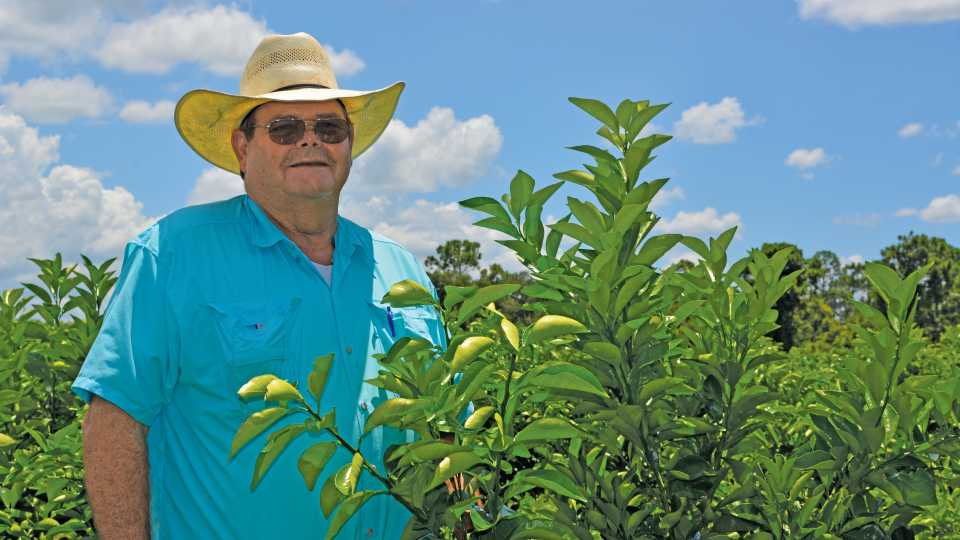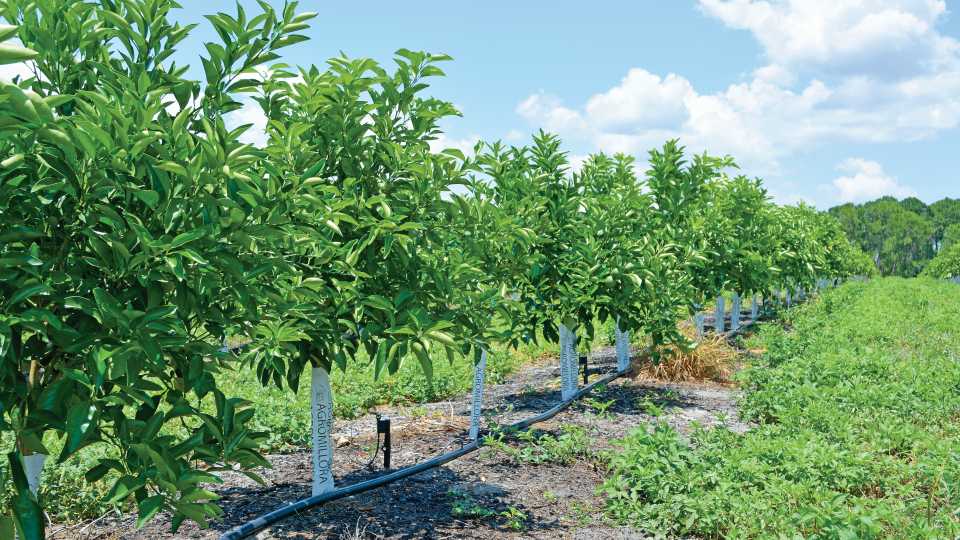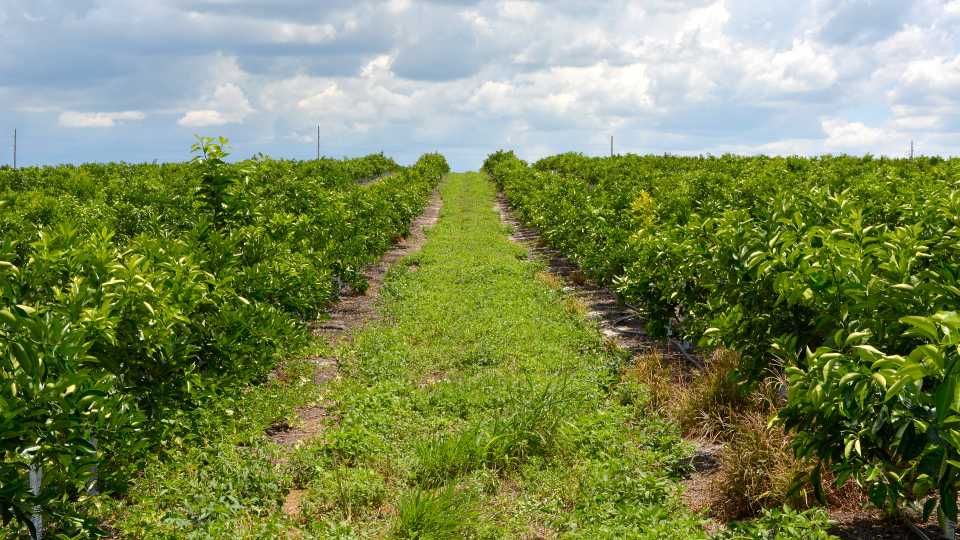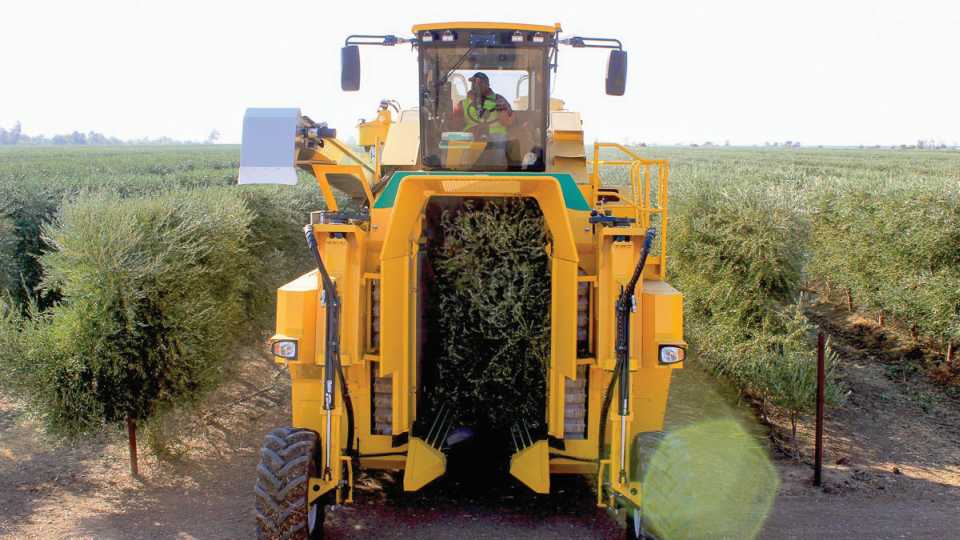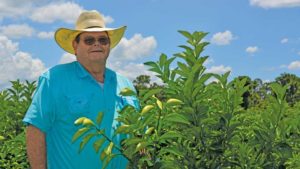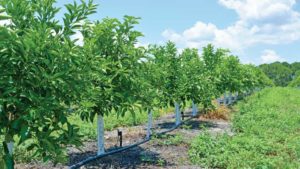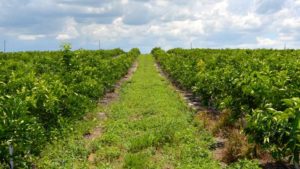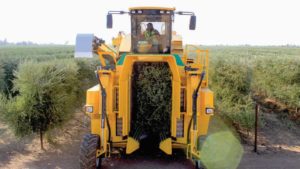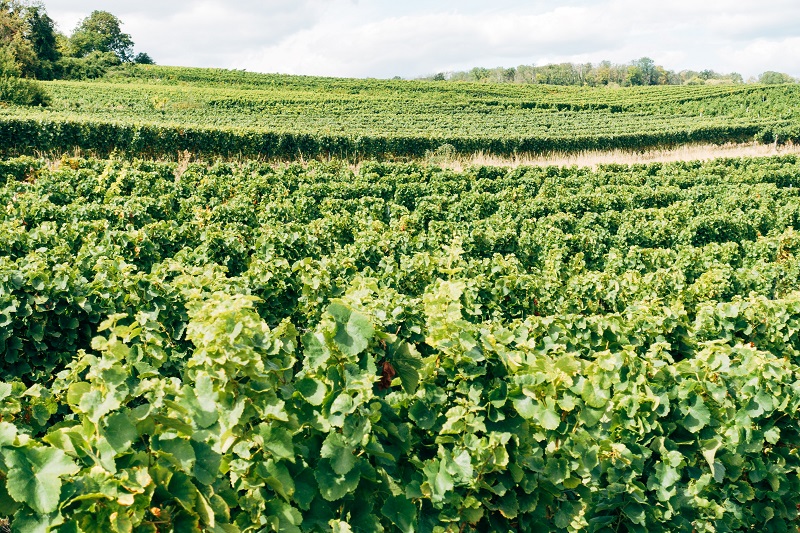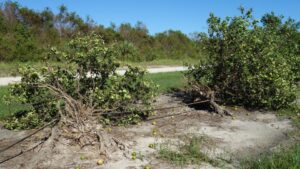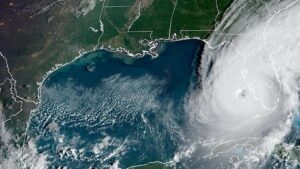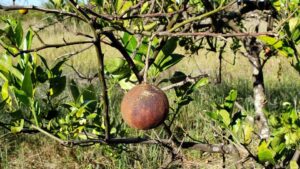Taking High-Density Citrus Planting to the Next Level
When you are told the experimental citrus grove you have planted is like no other in the country, you know it is a sign of the times and changes brought on by citrus greening. That’s what Horace Durrance was told about the 14-acre block of super high-density (SHD) trees planted on his Lost Lake Groves property near Lake Placid.
Durrance has been working closely with Dr. Clay Pederson, Managing Director of Agromillora Florida, on the project. As a third-generation citrus grower, Durrance says planting 908 trees per acre in the grove is a huge departure from the traditional 100 trees per acre planted by previous generations. But he is willing to give it a try for one simple reason — economics.
“My father and grandfather would probably roll over in their graves, knowing I am putting this many trees in the ground per acre,” Durrance jokes. “Back before greening came along, 100 trees per acre worked fine for generations, but now the economics just don’t work, as greening has reduced yields in traditional spacing and densities.”
Lost Lake’s super high-density citrus grove was planted in May 2018. While it remains to be seen if the experiment will be a success, early growth is impressive. Trees already are reaching about 4 feet in height and have developed an extensive root system.
“We had an irrigation leak about five weeks after we planted, which required us to dig underneath the trees to make repairs,” Durrance says. “In that short amount of time, the roots were already overlapping between trees. That got my attention.”
Keep Them Short
In Lost Lake’s super high-density citrus grove, trees are planted on 12-foot by 4-foot spacing. Several varieties and rootstocks are being tested (see sidebar) in the planting. Trees are planted on dwarfing rootstocks because the idea is to manage and grow them almost into a hedge, similar to how apple and olive orchards are grown today, minus the trellis.
“I think some of the growers who pioneered the work on higher density groves put varieties on regular rootstocks,” Durrance says. “Some of those trees got shaded out, and it just didn’t function correctly. We’ve got to keep these trees short for it to work.”
According to Pederson, they are taking what they have learned in other super high-density plantings from across the world and applying that knowledge in Lost Lake’s grove.
“One of the things that helped Agromillora get established as a company was propagating super high-density olive groves in Europe 25 years ago. We have talked about high density around the world, and here in Florida, for years. But what we are doing with Lost Lake Groves is a different way of approaching super high-density.”
Durrance says from a production standpoint, he is not treating super high-density citrus trees much differently than new resets in his conventional grove. There are a few exceptions to this, including his irrigation placement of one microjet for every two trees since the spacing is so close.
In addition, imidacloprid is being applied with a 1,000-gallon rear sprayer pulled behind a tractor going down every other row rather than using a hand-pump applicator, which is used on resets.
“You have 908 trees per acre, so that is a lot of hand pumping for our field workers,” Durrance says.
For weed control, Durrance built a herbicide boom to attach behind a John Deere Gator.
“I don’t have a disk that will fit the super high-density grove, so I am mowing it more than my conventional spacing,” he says.
The nutrition program is built around slow-release fertilizer. Since planting, the super high-density citrus block has received nine insecticide applications for psyllid control and other pests. Each of those applications have included foliar nutrition products.
“The slow-release fertilizer is a bigger expense on the front end,” he says. “But, in the long run you, are better off because you are saving on future applications. These roots are certainly competing to get that fertilizer. You can see that in the root and tree growth.”
Durrance says it’s too early for him to say if he will accrue any benefits from the super high-density citrus planting when it comes to greening. But, in theory, the much more compact plants would lend themselves to better coverage for psyllid-control applications. In addition, if a tree is taken out by the disease in a sea of 908 trees, it will impact production much less than if it were 100 trees per acre.
Continuous Hedge
The goal of using dwarfing rootstocks and continuous hedging is to create a compact tree. Durrance is hoping to grow the trees off to be about 7 feet to 8 feet tall and 3 feet to 4 feet wide.
“Right now, we are walking through this grove with clippers and hand trimming and shaping these trees,” he says. “We are doing this four times per year. As the trees get older, we will do this mechanically. I am still deciding on which piece of equipment I will use to hedge and top them. It will have to be something that cuts them clean and doesn’t tear the limbs.”
Mechanical Harvest
One of the biggest benefits derived from a super high-density citrus grove is that it lends itself to mechanical harvest. According to Pederson, this already is being done successfully in Spain. When Lost Lake Groves’ trees mature, the plan is to move to mechanical harvest, which will provide big savings on labor and harvest expenses.
The Oxbo 6430 and New Holland’s Braud 9090X are over-the-row harvesters capable of working in super high-density citrus groves. Pederson says the machines have performed well in other parts of the world, with 90% to 95% harvest efficiency — depending on the age and size of trees — and light damage to fruit and trees.
“Growers want to pick 100% of the fruit. But, if you are mechanically harvesting, you can leave a percentage on the tree and it still makes more economic sense,” Pederson says. “This is not the older shaker model where we tried to mechanically harvest existing groves. Here we are growing and grooming the trees to be harvested mechanically.”
The first harvest or two might not use the machines as the trees mature. In fact, ‘Vernia’ might be harvested for fresh fruit in the first harvest season, if the machines are not deployed. When mature, the goal is to pick about a half a box of fruit per tree, which would yield more than 450 boxes per acre.
Pederson adds that the super high-density approach will work for fresh fruit, but only for hand picking. He says they have not tested this on later Valencias out of fear of knocking off the next season’s crop with the machines.
We Are Doing Something
Durrance, like other growers, is observing the progression of citrus greening in his established groves. He watched trees fall off a cliff and then slowly begin to bounce back. He points to how trees responded after Hurricane Irma as an example. His groves endured 100+ mph winds during the storm.
“With Irma, I didn’t lose every leaf on this side of the grove, but I lost a big chunk of them,” Durrance says. “Driving through there, all you heard was fruit popping under the tires. We had bare twigs and fruit hanging. Given the history of greening, I thought those trees were not going to do anything for two years. But within seven days, we were getting feather growth on those twigs and even had a bloom that year.
“I don’t know what we are doing to take the stress factor off these greening-infected trees, but we are doing something that is helping. We have learned more about applying these minor elements. We have started applying 3 tons of compost per acre, twice per season. We are applying compost to the super high-density citrus grove at planting, and in the season as well. We have earthworms in these groves, which tells me we are headed in the right direction when it comes to soil and root health. Don’t get me wrong. I am not saying we have whipped greening’s stress factor, but we are helping these trees.”
As for the future super high-density citrus grove’s success, Durrance says time will tell, and they will adjust to conditions as the trees mature.
“We are just going to be farmers about it,” he says. “But so far, the trees look really good.”
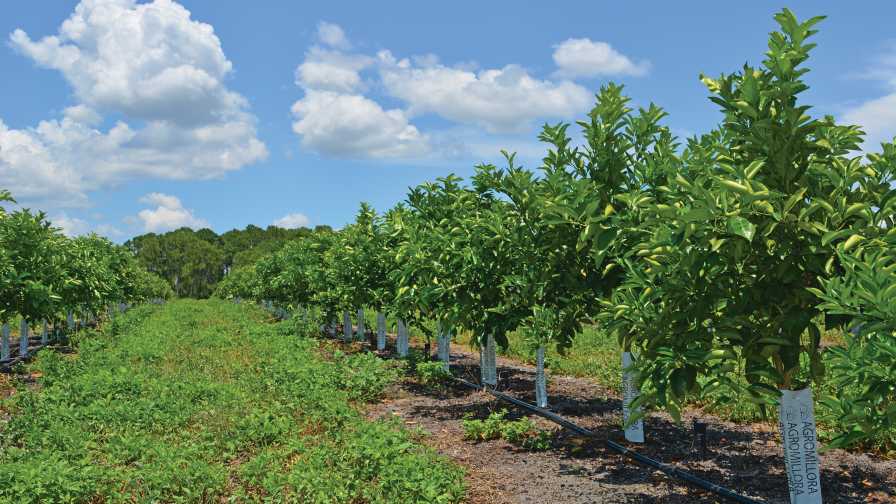
Photo by Frank Giles
Rootstock and Variety Combinations
Lost Lake Groves is testing various rootstock/scion combinations in its 14-acre super high-density grove. It is critical to utilize dwarfing rootstocks in the planting. Here are the various combinations being evaluated. The trees were produced by Agromillora using tissue culture technology, but the super high-density concept can be deployed with any nursery tree.
- ‘Vernia’ on US-897
- ‘Vernia’ on UFR-06
- ‘Valquarius’ on US-897
- ‘Valquarius’ on UFR-06





